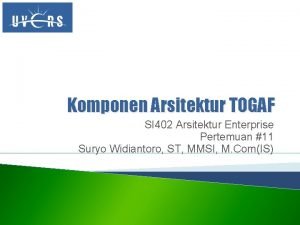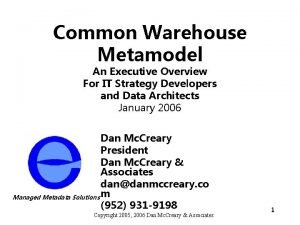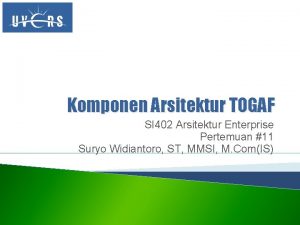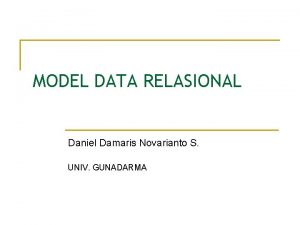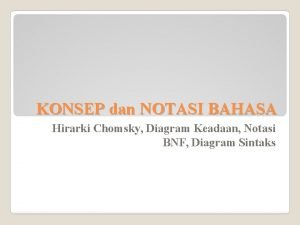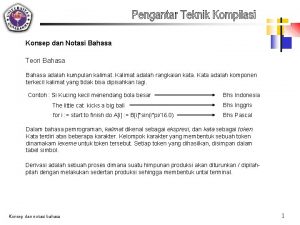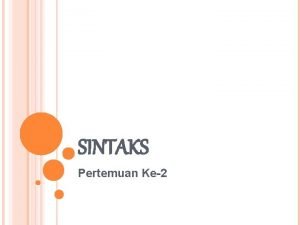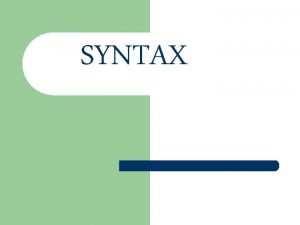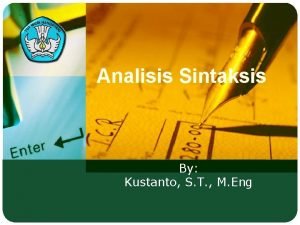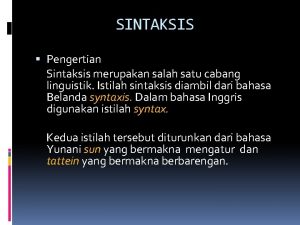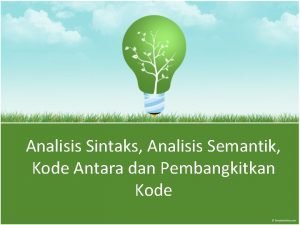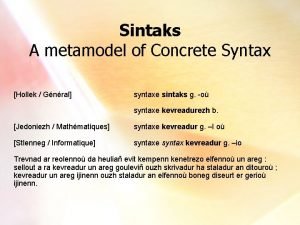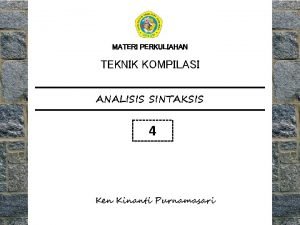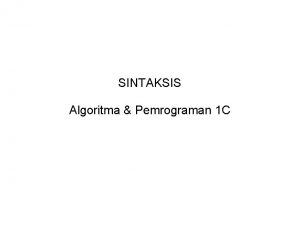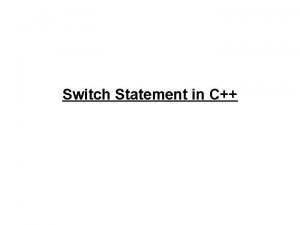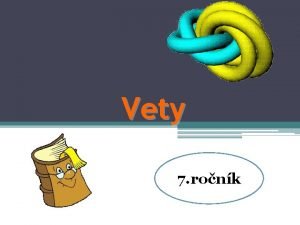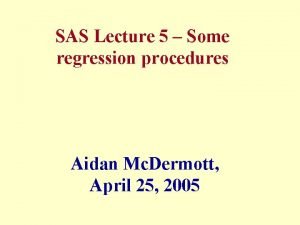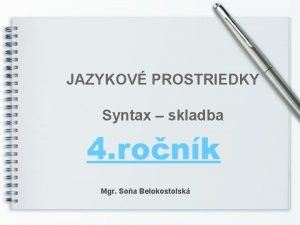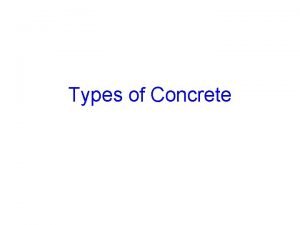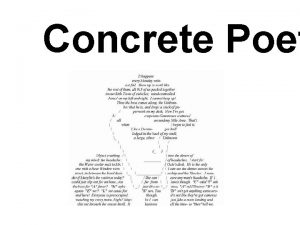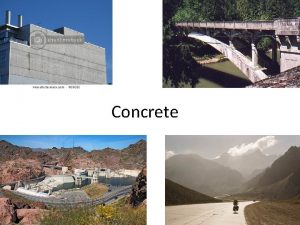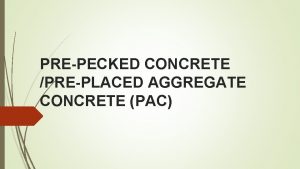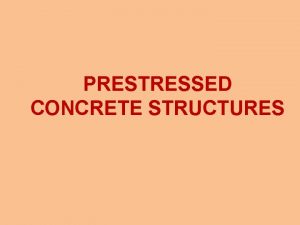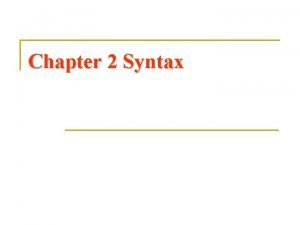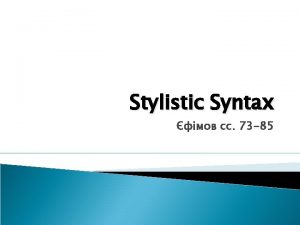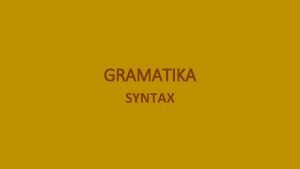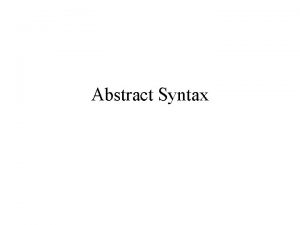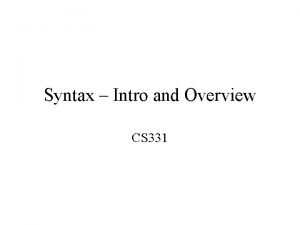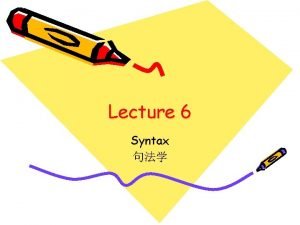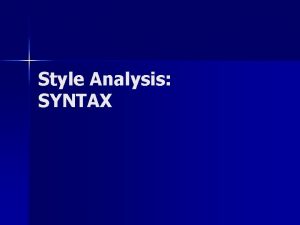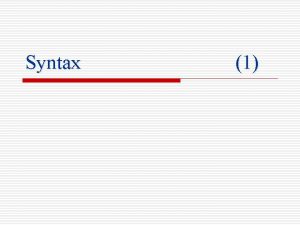Sintaks A metamodel of Concrete Syntax Hollek Gnral
![Sintaks A metamodel of Concrete Syntax [Hollek / Général] syntaxe sintaks g. -où syntaxe Sintaks A metamodel of Concrete Syntax [Hollek / Général] syntaxe sintaks g. -où syntaxe](https://slidetodoc.com/presentation_image_h/004488e657cd2da43bf21962125122bb/image-1.jpg)


























- Slides: 27
![Sintaks A metamodel of Concrete Syntax Hollek Général syntaxe sintaks g où syntaxe Sintaks A metamodel of Concrete Syntax [Hollek / Général] syntaxe sintaks g. -où syntaxe](https://slidetodoc.com/presentation_image_h/004488e657cd2da43bf21962125122bb/image-1.jpg)
Sintaks A metamodel of Concrete Syntax [Hollek / Général] syntaxe sintaks g. -où syntaxe kevreadurezh b. [Jedoniezh / Mathématiques] syntaxe kevreadur g. –I où [Stlenneg / Informatique] syntaxe syntax kevreadur g. –io Trevnad ar reolennoù da heuliañ evit kempenn kenetrezo elfennoù un areg : sellout a ra kevreadur un areg gouleviñ ouzh skrivadur ha staladur an ditouroù ; kevreadur un areg ijinenn ouzh staladur an elfennoù boneg diseurt er gerioù ijinenn.

Model-Driven Analysis and Synthesis of Concrete Syntax Mo. DELS’ 06 Genova Pierre-Alain Muller Franck Fleurey Frédéric Fondement Michel Hassenforder Rémi Schneckenburger Sébastien Gérard Jean-Marc Jézéquel

Summary • • • Introduction Concrete syntax metamodel Synthesis semantics Analysis semantics Examples Conclusion Model-Driven Analysis and Synthesis of Concrete Syntax 3

Gentle Reminder Sintaks MOF Abstract Syntax D SL Concrete Syntax Kermeta Semantic Domain Model-Driven Analysis and Synthesis of Concrete Syntax 4

Motivation • In general : How to create models conforming to metamodels ? By program or with reflexive editors • In the context of language engineering How to create textual representation of models conforming to metamodels ? Grammarware : compiler (text -> AST -> Model) Modelware : text <-> Model-Driven Analysis and Synthesis of Concrete Syntax 5

Example • A very simple metamodel Mail: Type • Typical concrete syntax Type Mail { From : User To : User } Type User { Name : String } Type String; From: Attribute User: Type To: Attribute: Name String: Attribute Model-Driven Analysis and Synthesis of Concrete Syntax 6

Process overview Meta-Language (Mof, Kermeta, …) Conforms to Concrete Syntax Metamodel Abstract Syntax Metamodel Conforms to Concrete Syntax Model Conforms to Text Model Generic analyser and synthesizer Bidirectionnal Transformation Model-Driven Analysis and Synthesis of Concrete Syntax 7

Concrete syntax metamodel Nice Picture Isn't it ? Model-Driven Analysis and Synthesis of Concrete Syntax 8

Concrete syntax metamodel • Class and Feature Bridges to the target metamodel • Rule Abstract base class • Root Entry point Owns everything (features, classes, fragment of rules) Gives the starting rule Model-Driven Analysis and Synthesis of Concrete Syntax 9

Concrete syntax metamodel • Template A connection between a class of the metamodel and its corresponding concrete syntax (rule) • Sequence As usual, specifies an ordered collection of rules • Terminal Constant text value known at modeling time (a terminal symbol in grammarware) Model-Driven Analysis and Synthesis of Concrete Syntax 10

Concrete syntax metamodel • Value A feature from a class whose value will be read or written • Primitive. Value The representation of base types : Integer, String, Real, Boolean • Object. Reference A reference between classes from the abstract syntax • Rule. Ref Invoke another rule (typically a fragment owned by Root) Allow factorization and sharing of concrete representation Model-Driven Analysis and Synthesis of Concrete Syntax 11

Concrete syntax metamodel • Iteration Handles a collection over items of the abstract syntax • Alternative Variations in the concrete syntax The alternative is driven by an ordered collection of conditions • Custom. Condition Checks a feature of a given class • Polymorphic. Condition Checks the class name Model-Driven Analysis and Synthesis of Concrete Syntax 12

Synthesis/Analysis • Synthesis Model-driven recursive descent template engine A depth-first visitor • Analysis CACKESKFELPROTO Model-driven recursive descent generic compiler Like LL(k) Synthesis Text Model Analysis Model-Driven Analysis and Synthesis of Concrete Syntax 13

Synthesis semantics • Template rule The template specifies which object to serialize The sub-rule is invoked to generate the corresponding text • Terminal rule The terminal value is appended to the output stream Add formatting information, such as white space • Primitive. Value rule Get the feature in the current object Convert it to a string and append it to the output stream • Object. Reference rule Get the referred object Extract the key field Print it to the output stream Model-Driven Analysis and Synthesis of Concrete Syntax 14

Synthesis semantics • Iteration rule The sub-rule is applied to each object in the collection The optional separator is inserted between each invocation • Alternative rule The conditions are evaluated in the order defined in the collection The first that resolves to true triggers the associated rule Model-Driven Analysis and Synthesis of Concrete Syntax 15

Analysis Semantics • Template rule The associated metaclass is instantiated and is set as current object The sub-rule is invoked If an error occurs the current object is dismissed • Terminal rule Extract a string from input stream If it is equal to the terminal then the text is consumed else throws exception • Primitive. Value rule Extract a string from input stream Assign it to the corresponding feature of the current object Model-Driven Analysis and Synthesis of Concrete Syntax 16

Analysis Semantics • Object. Reference rule Extract the key reference from the input stream Query the model with that key If a matching element is found then update the feature of the current object else the parser creates a ghost By the end of the parsing process, all ghosts have to be resolved • Iteration rule The sub-rule (and separator, if specified) is invoked repetitively until failure For each successful invocation update the collection of the current object • Alternative rule No clue in the input stream to determine the condition Infer this condition Try each branch of the alternative until there is a match Ordered collection of conditions handles priorities between sub-rules Model-Driven Analysis and Synthesis of Concrete Syntax 17

Examples • Example 1 : Type • Example 2 : Expression - prefixed • Example 2 : Expression - infixed Model-Driven Analysis and Synthesis of Concrete Syntax 18

Example 1 : Type / Metamodel & Model Type Mail { From : User To : User } Type User { Name : String } Type String; Model-Driven Analysis and Synthesis of Concrete Syntax 19

Example 1 : Type / Concrete Syntax Model Working on Model Fill a collection Working on Type Extract the type name Just a semicolon Fill a collection Working on Attribute Extract the attribute name Extract the ref to a type Model-Driven Analysis and Synthesis of Concrete Syntax 20

Example 1 : Type / Concrete Syntax Model Working on Model Call fragment about Type Working on Type Call fragment about Attribute Working on Attribute Model-Driven Analysis and Synthesis of Concrete Syntax 21

Example 2 : Expression / Metamodel Model-Driven Analysis and Synthesis of Concrete Syntax 22

Example 2 : Expression / prefixed Prefixed notation operator + ( operator * ( 3, 2 ), 1 ) Infixed notation 3*2+1 Model-Driven Analysis and Synthesis of Concrete Syntax 23

Example 2 : Expression / infixed <Additive. Op> : : = <Term> ‘+’ <Expr> <Multiplicative. Op> <Term> : : = <Factor> ‘*’ <Number. Integer> : : = [0 -9]+ <Expression> | : : = <Additive. Op> <Term> | : : = <Multiplicative. Op> <Factor> : : = <Number. Integer> Model-Driven Analysis and Synthesis of Concrete Syntax 24

Conclusion • Experimentation for the specification of concrete syntax in the context of meta-modeling applied to language engineering • Novel approach, based on metamodels • Bi-directional mapping concrete-to-abstract syntax abstract-to-concrete syntax • A prototype Available at http: //www. kermeta. org/download (…sintaks) Implemented on top of EMF in Eclipse Recursive descent parser Recursive descent pretty-printer Model-Driven Analysis and Synthesis of Concrete Syntax 25

Future • Model-driven Generic Syntactic Editor • Enhance the rule set Optional Iteration 0. . *, 1. . *, n. . m Separator vs Terminator Embedded rule references • Add concepts to drive the lexical analyzer e. g. pattern matching • Integrate Grammarware concepts and tools Add a checker of the concrete syntax Check if the syntax is not ambiguous Check if a DFA could be constructed Model-Driven Analysis and Synthesis of Concrete Syntax 26

Questions • First shot • Not a definitive answer… ? Model-Driven Analysis and Synthesis of Concrete Syntax 27
 Arsitektur enterprise
Arsitektur enterprise Common warehouse metamodel
Common warehouse metamodel Common warehouse metamodel
Common warehouse metamodel Komponen togaf
Komponen togaf Syntax directed translation scheme
Syntax directed translation scheme Concrete semi concrete abstract
Concrete semi concrete abstract Concrete semi concrete abstract
Concrete semi concrete abstract Contoh kalkulus relasional tupel
Contoh kalkulus relasional tupel Bentuk notasi bnf
Bentuk notasi bnf Diagram sintaks
Diagram sintaks Yang memeriksa sintaks dan memeriksa relasi adalah
Yang memeriksa sintaks dan memeriksa relasi adalah What is syntax
What is syntax Jelaskan definisi derivasi dan pohon sintaks!
Jelaskan definisi derivasi dan pohon sintaks! Contoh kesalahan sintaks
Contoh kesalahan sintaks Sintaksis adalah
Sintaksis adalah Analisa sintaks
Analisa sintaks Sintaks role playing
Sintaks role playing Datapwat halimbawa
Datapwat halimbawa Sintaks
Sintaks Diagram sintaks teknik kompilasi
Diagram sintaks teknik kompilasi Parsing adalah
Parsing adalah Nadväznosť synonymum
Nadväznosť synonymum Switch c++ example
Switch c++ example Oznamovacia veta
Oznamovacia veta Notasi bnf
Notasi bnf Proc logistic syntax
Proc logistic syntax Example of periodic sentence
Example of periodic sentence Skladba syntax
Skladba syntax
